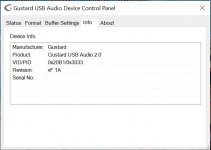...The AK4499EQ in the DC500...Compared to the ESS9038pro...
You are not comparing dac chips so much as comparing particular implementations of dacs, using, among other things, two different dac chips. A lot of any difference in SQ will have to do with clocking, power supplies, output stage topology, etc.
So far I have not seen a commercial AK4499 based dac that gets shows off what the dac chip can do at its best. Topping D90 is pretty good, with great bass and imaging, but at vocal frequencies and above there is something about the it's sound that is a little 'off.' It doesn't sound natural at those frequencies, although the problem is small enough that some people never notice it, while other people can't stand it.
As far as the best dacs go, Chord DACs with aftermarket analog power supplies and a prescaler may be the best sounding Sigma-Delta types. For people that don't like SD sound, Holo May seems to be the favorite of most for now.
Either spend the money or don't, but don't assume that other dacs are so close to being just as good as the best ones so that no practical audible difference exists. What is or isn't audible depends a lot on how the listener's brain processes audio. Whether or not a listener cares about the sound of particular small audible imperfections is another personal factor.
Agreed - I'm not comparing the DAC chip as much as DC500 and Gustard x26 Pro units. I keep going back & forth between the two. The music is so much more engaging on the DC500. This is a dual DAC chip implementation which I think is different than the Topping D90. Early on I was also hearing some of that un-naturalness in female vocals but it's gone now. The DC500 seems to need time to warm up; I no longer bother turning it off anymore. Also, I figured out how to turn off this Chinese "echo" nonsense - select "Super Slow Roll-Off" for no echo.
Last edited:
Final thoughts. Both DAC's are good - really good. But, the DC500 goes lower and the bass is more taught. And there are more highs. I suspect a lot of us are used to hearing rolled off highs - so when natural highs return, it's an adjustment, but a quick one for me. The big one for me is the rhythm and dynamics - the DC500 has a better beat & pace. I suspect the firmer bass lines help but its more than that - i.e. there is more pluck on strings. I switched to the "Super_S" setting as I think it sounds more natural.
@markkpa Did you test x26 Pro with default settings? NOS mode is off, PCM filter is VIVID at default settings.
I find quite interesting that you pick 600$ cheaper unit. I couldn't find any published measurements of DC500. Did you buy it without knowing how it measures?
I find quite interesting that you pick 600$ cheaper unit. I couldn't find any published measurements of DC500. Did you buy it without knowing how it measures?
Last edited:
Yes, NOS mode was off and PCM filter was Vivid. I searched for the best dual AK4499EQ DAC I could find. Sounds even better with more listening hours. However it does not support MQA whereas the x26 Pro does. I stream from Qoboz and MQA is not a big deal for me.
Some retailers sold X26 Pro with wrong firmware version which makes filter settings don't take any effect. I suggest you to check your firmware version. Correct version is f.1a.
I don't consider MQA as a deal breaker. I don't take it seriously.
Attachments
Last edited:
Actually, I sold the x26 Pro and kept the DC500 (the cheaper DAC) because it sounded better.
Ok then. But there was a high chance of that you used x26 Pro with wrong firmware. For instance, the one that tested at audiosciencereview.com was flashed with wrong firmware and results were disappointing. After they corrected the firmware, things got clear.
Last edited:
Not really. The USB parts are critical. And so are the output analogue stages. Not easy to make valid comparisons between dac chips when important, external to the chips factors differ.
more thn true. dac-s modules shoud be in the same input/output/power modules when comparing dacs ICs.
.
This is test with 2 devices more than than DAC Ics?
.
But still it is good report I think?
These days power/input/output stages are made with almost same fashion. regulators,USB interfaces, OPamps topologies and types, crystal oscilators, are almost the same or very close model to model?
.
cheers
- Home
- Source & Line
- Digital Source
- A/B Listening Test - AK4499eq vs ESS9038pro
